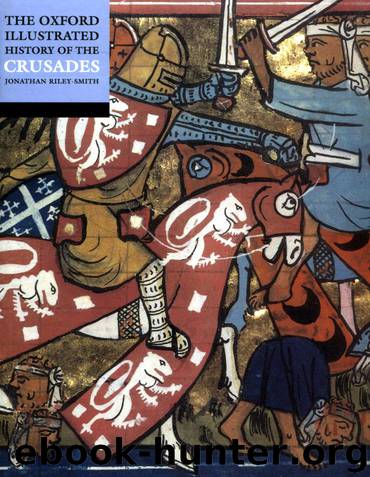The Oxford Illustrated History of the Crusades (Oxford Illustrated Histories) by Unknown

Author:Unknown
Language: eng
Format: epub
Published: 2010-02-04T21:09:00+00:00
Organization
In the years immediately following its foundation, a military order consisted of a small group of brethren under the leadership of a master: at this stage little governmental machinery was needed. As property and recruits were gained, however, it became the norm to establish subordinate convents, both in frontier regions and elsewhere. If expansion was considerable, an intermediate tier of government between convents and an order's headquarters was soon needed, since it became difficult for masters to supervise distant convents, and a system was needed by which resources and recruits could easily be channelled to frontier regions from convents in other parts of western Christendom. Orders which fought on several fronts also required a military leader in each district. The forms of organization then existing in the monastic world hardly suited the purposes of military orders, and the more important of these adopted the practice of grouping the convents in a region into what were called provinces or priories. Although there were variations in detail, the leading orders adopted a three-tier system of government.
In frontier districts, convents were often located in castles and had military responsibilities, whereas elsewhere a primary task was the administration of property in the surrounding district. Most members of a convent were normally lay brethren, though some orders, such as Santiago, had a number of separate convents for clerics, and several military orders possessed houses of sisters. Convents of sisters sometimes contained as many as forty or fifty members, but male houses away from frontier regions usually contained no more than a handful of brothers, who were far outnumbered by the outsiders who lived or worked there. The head of a convent was generally called a `preceptor' or `commander' and was normally imposed from above, and not elected by the members of the house. He had to see that the rule was followed, and in frontier districts he led his brethren in the field; he was also responsible for the administration of his convent's property, from the revenues of which in nonfrontier districts a portion had to be paid each year to his superior. He had few subordinate officials, but was expected to govern with the advice of the conventual chapter, which normally met once a week. Heads of provinces or priories were also appointed from above, and had functions similar to those of commanders. In the Temple, Hospital, and Teutonic Order, heads of provinces in western Europe were normally under the obligation of sending a responsion of a third of their provinces' revenues to headquarters. At this level there were again few assistant officials, but provincial masters were counselled by provincial chapters, which met annually and were attended by heads of convents. At the headquarters of the leading orders, the master was assisted by officials who included a grand commander, a marshal with military responsibilities, and a drapier who had charge of clothing; these offices are not, however, encountered in smaller orders. A master would consult the members of his central convent, who presumably met
Download
This site does not store any files on its server. We only index and link to content provided by other sites. Please contact the content providers to delete copyright contents if any and email us, we'll remove relevant links or contents immediately.
| Automotive | Engineering |
| Transportation |
Whiskies Galore by Ian Buxton(41885)
Introduction to Aircraft Design (Cambridge Aerospace Series) by John P. Fielding(33064)
Small Unmanned Fixed-wing Aircraft Design by Andrew J. Keane Andras Sobester James P. Scanlan & András Sóbester & James P. Scanlan(32744)
Craft Beer for the Homebrewer by Michael Agnew(18145)
Turbulence by E. J. Noyes(7942)
The Complete Stick Figure Physics Tutorials by Allen Sarah(7310)
Kaplan MCAT General Chemistry Review by Kaplan(6868)
The Thirst by Nesbo Jo(6832)
Bad Blood by John Carreyrou(6558)
Modelling of Convective Heat and Mass Transfer in Rotating Flows by Igor V. Shevchuk(6392)
Learning SQL by Alan Beaulieu(6213)
Weapons of Math Destruction by Cathy O'Neil(6149)
Man-made Catastrophes and Risk Information Concealment by Dmitry Chernov & Didier Sornette(5925)
Digital Minimalism by Cal Newport;(5667)
Life 3.0: Being Human in the Age of Artificial Intelligence by Tegmark Max(5476)
iGen by Jean M. Twenge(5367)
Secrets of Antigravity Propulsion: Tesla, UFOs, and Classified Aerospace Technology by Ph.D. Paul A. Laviolette(5311)
Design of Trajectory Optimization Approach for Space Maneuver Vehicle Skip Entry Problems by Runqi Chai & Al Savvaris & Antonios Tsourdos & Senchun Chai(5011)
Pale Blue Dot by Carl Sagan(4914)
